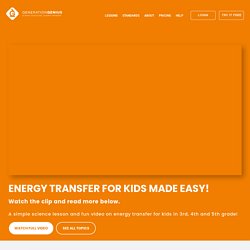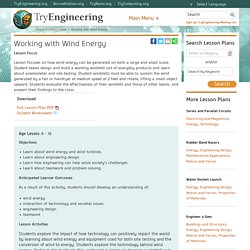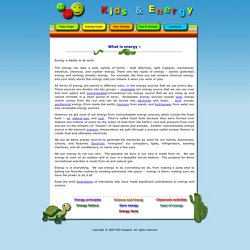

Energy Transfer Lesson for Kids. What is energy?

Energy is the ability to do work. There are many different kinds of energy, such as light, sound, and heat. We need energy for our homes to power lights, refrigerators, air conditioners, and computers. We use energy when we drive cars or pedal a bike. What is Energy? Generating Electricity – Origami Organelles. Lighting the Way with Solar Energy / Connected 2015 level 4 - Is That So? / Connected / Instructional Series / English - ESOL - Literacy Online website - Instructional Series.
RENBOC_1 - OpenLearn - Open University - RENBOC_1. StudyJams! Science Activities. Energy Transfers & Transformations. STEM wind power challenge. Working with Wind Energy. Lesson Focus Lesson focuses on how wind energy can be generated on both a large and small scale.

Student teams design and build a working windmill out of everyday products and learn about anemometer and site testing. Student windmills must be able to sustain the wind generated by a fan or hairdryer at medium speed at 2 feet and rotate, lifting a small object upward. Students evaluate the effectiveness of their windmill and those of other teams, and present their findings to the class. Age Levels: Objectives Learn about wind energy and wind turbines.Learn about engineering design.Learn how engineering can help solve society's challengesLearn about teamwork and problem solving. Anticipated Learner Outcomes As a result of this activity, students should develop an understanding of: wind energyinteraction of technology and societal issuesengineering designteamwork Lesson Activities Resources/Materials.
Tidal Energy Experiment. Geothermal energy experiments fro ks2. Solar car design ideas. The One Moment - OK Go Sandbox. Cooling for all, without warming the planet. Turbulent Is Ready to Change the World! PrimaryEnergyInfobookActivities. Energy Infobook Activities (Free PDF Download) – The NEED Project. ENERGY TRANSFORMATIONS~Science For Fun. We Can Power The World With Algae! Adv. and disadv. of renewables and non-renewables by kenronald - Teaching Resources - Tes. Nuclear Power Station Concept Cartoon by olivia_calloway - Teaching Resources - Tes. Penn State Engineering: Where the rivers meet the Sea: Harnessing the energy generated when freshwater meets saltwater. Harnessing the energy generated when freshwater meets saltwater By Jennifer Matthews UNIVERSITY PARK, Pa. – Penn State researchers have created a new hybrid technology that produces unprecedented amounts of electrical power where seawater and freshwater combine at the coast.

“The goal of this technology is to generate electricity from where the rivers meet the ocean,” said Christopher Gorski, assistant professor of environmental engineering at Penn State. “It's based on the difference in the salt concentrations between the two water sources.” That difference in salt concentration has the potential to generate enough energy to meet up to 40 percent of global electricity demands. PRO, the most common system, selectively allows water to transport through a semi-permeable membrane, while rejecting salt. “PRO is so far the best technology in terms of how much energy you can get out,” Gorski said.
A third technology, capacitive mixing (CapMix), is a relatively new method also being explored. Heat energy. Renewable energy sources. Renewable energy is fuel that comes from a source that can be replenished in a short amount of time. This includes solar, wind, water, geothermal power and bioenergy. While renewable energy sources may not always be available – for example, if there is no wind to drive wind turbines, or cloudy days that reduce solar energy – they play an important part in reducing the use of non-renewable resources. Furthermore, many of these resources do not emit greenhouse gases directly into the atmosphere. Solar power In the broadest sense, solar power supports all life on Earth and is the original source for all other energy resources we use. Having produced solar radiation for millions of years through nuclear fusion, this powerhouse produces so much energy that the amount of sunlight that reaches the Earth in a single hour could meet the energy demands of the whole world for an entire year!
Renewable energy sources. KS2 Bitesize Science - Friction : Play. Friction is a force between two surfaces that are sliding, or trying to slide, across each other.

For example, when you try to push a book along the floor, friction makes this difficult. Friction always works in the direction opposite to the direction in which the object is moving, or trying to move. Friction always slows a moving object down. The amount of friction depends on the materials from which the two surfaces are made. The rougher the surface, the more friction is produced. Friction can be a useful force because it prevents our shoes slipping on the pavement when we walk and stops car tyres skidding on the road.
Sometimes we want to reduce friction. Energy Forms and Changes - Energy. Topics Energy Conservation of Energy Energy Systems Energy Forms Energy Changes Thermal Energy Description Explore how heating and cooling iron, brick, and water adds or removes energy. Science Video for Kids: What Is Energy? What Is Energy - Lesson for Kids - 25SDA. Energy and kids. Energy and kids. Energy is Ability to do work.

The energy can take a wide variety of forms - heat (thermal), light (radiant), mechanical, electrical, chemical, and nuclear energy. Friction 1.1.0. Jaycar Electronics New Zealand. Jaycar Electronics New Zealand.